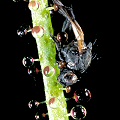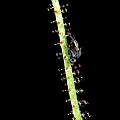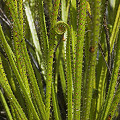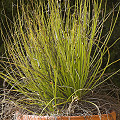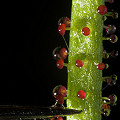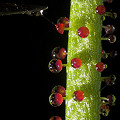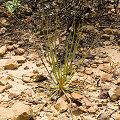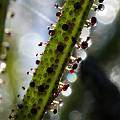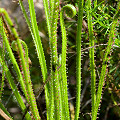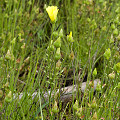Q: Drosophyllum: the Portuguese slobbering pine
A: Drosophyllum, at first glance, appears to be a relatively
unspecialized flypaper plant. Its general habit is much like that of a sundew---its long, deep green
whiplike leaves are covered with short-stalked tentacles tipped with red glands. The tentacles do not move, nor does the leaf move in
response to prey. Prey captured by the leaves are digested by enzymes released by the stalked glands and
also the (usually green) sessile glands. The sessile glands
are only activated if they are smeared by tentacle mucus, and if the nearby tentacles are agitated by struggling prey.
Drosophyllum is a large plant! The leaves are well over 30 cm (12 inches) long,
and mature plants can be 0.6 m (2 feet) tall. Plants in shade can be nearly three times as tall, but more straggly in build.
Drosophyllum has interesting adaptations that set it aside from other flypaper plants. First, the plants have an aromatic, honeylike smell that is very similar to that of Darlingtonia. Also, Drosophyllum has an intriguing hunting strategy unique among the flypaper plants. Instead of using mucus to glue the prey to the leaf, Drosophyllum is quite satisfied to let the prey wander about the leaf. But as the bug wanders about, it bumps from one mucus-blob to another. Each time, mucus is transferred from the leaf to the bug, and soon the prey is completely coated with goo. A bug covered with slime cannot breathe, so the beslimed bug suffocates. I believe that this strategy is, in effect, much like a pitfall trap since the bug descends the leaf by gravity until it drowns.
As a common name, most growers simply use the plant's genus name, which simply translates to "leaf like a sundew's".
However, some English-speaking horticulturists call
this the "dewy pine". The dewy part of the name needs no explanation; the pine part is due to the fact that the general
form of the plant is similar to the shape of a seedling, long-needled pine plant. However, I am campaigning for adoption of
the name "slobbering pine", which is based upon the delightful Portuguese common name pinheiro baboso.
The specific epithet lusitanicum comes from the word Lusitania, which was a province in the Roman Empire
that corresponds to what is now Portugal---the stronghold for the slobbering pine.
Page citations: Fenner, C.A. 1904; Juniper, B.E. et al. 1989;
Rice, B. 2006a, 2007a.
